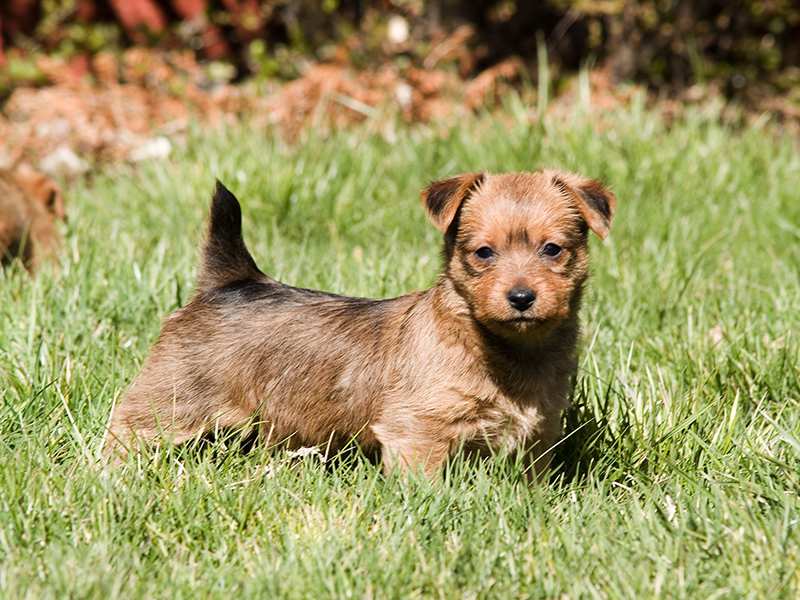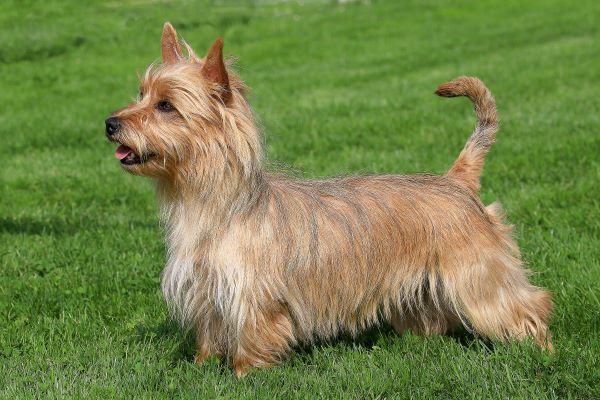Australian Terrier


| Recommended for | Singles, families |
| Breed Classification | Terrier |
| Other names | The Aussie Terrier, The Aussie |
| Lifespan | 12-15 years |
| Size | Small |
| Temperament | Alert, affectionate, loyal, courageous |
| Intelligence | High |
| Tendency to bark | High |
| Maintenance Level | Medium |
| Health Risk | This breed has an around average probability of having health issues in its lifetime, hence it is one of the more affordable breeds to insure. |
Insuring an Australian Terrier?
Get award-winning cover with more benefits and up to 80% of eligible vet bills reimbursed. Find out about your cover options.
Get a quick quote
Is this breed right for you?
Try our breed selector quiz to find out your best matching breed!
Insuring an Australian Terrier?
Get award-winning cover with more benefits and up to 80% of eligible vet bills reimbursed. Find out about your cover options.
Get a quick quote
Breed history of Australian Terriers
The Australian Terrier is thought to have descended from the old “Scotch” Terrier and other Terriers brought to Australia from the United Kingdom, such as the Cairn Terrier, Norwich Terrier, Dandie Dinmont Terrier, Skye Terrier, Yorkshire Terrier and Black and Tan Terrier.
Among the smallest of the working terriers, Australian Terriers were bred out of a need for a sturdy and courageous working dog, adaptable to Australia’s harsh climate. Aside from controlling and killing rats and snakes, their roles included watchdog, shepherd and companion dog.
The Australian Terrier was the first native Australian breed to be officially recognised and shown in Australia. The first club devoted to the breed was founded in Melbourne in 1887, and a breed standard was devised there. Imports to America and Britain began soon after, and it became the first Australian breed to be officially recognized in these countries.

Physical description of Australian Terriers
The Australian Terrier is one of the smallest terrier breeds. It is sturdy and short-legged with a longish torso, long neck, triangular, erect ears and dark brown eyes.
Aussie Terriers have a soft undercoat and a harsh outer coat that embues an unkempt, rough-and-ready appearance. A topknot of soft, silky hair contrasts in texture with their otherwise harsh coat. They come in three colours: blue and tan, sandy, and red.
| Weight range | 5.5 to 7 kg |
| Height range | 23 to 28 cm |
| Colours | Blue & tan, red or sandy |
| Coat length | Medium |

Australian Terrier personality and temperament
The Australian Terrier is a friendly, intelligent, tough and adaptable little dog who loves to please its owners. Like most terrier breeds, the Aussie Terrier tends to be bossy and will nudge or bark at you until they get what they want. Don’t be fooled by their innocent looks and adorable head tilt – they will take over your household if you let them!
Aussies were bred to hunt vermin, and this instinct is still very strong in their temperaments. Courageous, protective and alert, they are natural watch dogs, and will sound the alarm should any strange dog or person approach the house. Although not a fighter, they are jealous of their territory and will defend it – and their owners – till the end, whether from much larger dogs, smaller pets or vermin.
Australian Terriers were also developed as a companion dog and are happiest when with their people. Aussies are not suited to living outside or spending long hours in a run or fenced yard alone. They will curl up in their owner’s lap at the slightest invitation!

Australian Terriers with kids and other pets
Most Aussie Terriers are good with children as well as senior citizens, so they make excellent family pets. As with any small dog, supervision with toddlers is essential, for the dog’s protection as well as the child’s. Aussies may be more suitable for households with older kids as they tend to be a little bit wary of children and their bossy temperament can be too pushy for some.
As with other terriers, Aussies can be dog-aggressive and somewhat bossy, and care must be taken when living in a multi-pet household.

Australian Terrier training and exercise
Terriers in general have a high energy level, and the Australian Terrier is no exception. The breed is very active and requires regular exercise to keep it from becoming bored and unhappy. Daily play sessions, indoors or out, will keep Aussies happy and well adjusted. They consider a game of chase to be great fun, and at the park they will want to chase a ball or other dogs around for hours. With their boundless energy, they can also excel in agility or other dog sports.
Play sessions must take place is a securely fenced area, and when on walks or hikes, Aussies must be on a leash. They should never run loose as their instinct to hunt is very strong, and they might not be able to resist running off to chase a cat or other small animal, and they might pursue their ‘prey’ so far that they can’t find their way back.
Unlike some other Terrier breeds, the Aussie Terrier tends to be more obedient and easier to train, though they can be quite stubborn. Training and socialising Aussies from a very young age is the best way to ensure they become well-rounded companions.
| Energy level | Very high |
| Exercise requirements | High |

Australian Terrier feeding and nutrition
The Australian Terrier should do well on a high-quality, balanced and wholesome dog food that is appropriate for its age (puppy, adult, or senior), size and activity level. To aid a healthy growth and prevent problems in later years, puppies require a specially formulated diet, with higher protein, fat, calcium, and other vitamins and minerals. Avoid commercial dog foods made mostly from carbohydrates, including rice, wheat and corn.
Dogs can become overweight so it’s important to monitor their weight and calorie consumption. Avoid feeding excessive table scraps or overindulging them with treats. Check with your vet if you have any concerns about your dog’s weight or diet.

Australian Terrier care and grooming
The Australian Terrier sheds little enough to qualify as non-shedding. Their harsh, weatherproof, double coat does a good job of repelling dirt and mud, and is very easy to maintain. A brush once a week, a pluck or trim of the long hairs around the eyes as needed and a bath only when necessary should be enough to keep your Aussie in top shape.
Frequent baths are not recommended as shampooing softens the Aussie’s coarse, straight coat, which makes it less able to shed dirt naturally, and can lead to dry and flaky skin.
Health issues for Australian Terriers
- Patella luxation occurs when the bones of the kneecap are not aligned properly and as a result slip in and out of place, causing pain and an abnormal gait. Mild cases generally do not require treatment and do not impact too much on the dog’s life, but severe cases may require surgery.
- Legg-Perthes disease affects the hip joint and has been known to affect small dog breeds. It lowers the blood supply to the femur and causes the pelvis to disintegrate. Symptoms such as limping and atrophy of the leg muscle occur around the age of 4 to 6 months. Surgery can be undertaken to remove the affected area and the resulting scar tissue creates a “false joint” and the dog usually ends up pain-free.
- Diabetes is a metabolic disease that occurs when the body cannot regulate blood sugar levels. Affected dogs do not lose their appetite, but will often lose weight, urinate a lot and get thirsty often. It is treated with a special diet and insulin.
- Allergies can occur in Australian Terriers, including food allergies, contact allergies and inhalant allergies. Allergies for dogs are itchy, irritating, uncomfortable, annoying and sometimes very painful. On top of this, all the dog’s scratching and licking of the itchy skin can cause secondary infections which result in increased itching, irritation, pain and discomfort. Treatment usually involves removal of the allergen from the dog’s environment or medication.
- Cataracts are an opacity of the lenses of the eye that prevent light from reaching the retina, leading to vision impairment. Cataracts can develop in one or both eyes and they may progress slowly or rapidly, leading to vision impairment and/or blindness. They can usually be removed surgically.
- Hypothyroidism occurs when the thyroid gland does not produce enough of the thyroid hormone. Symptoms include epilepsy, loss of hair, fatigue and patchy skin. It is treatable with medication and a special diet.
Not all conditions are covered by Pet Insurance. For details of Bow Wow Meow Pet Insurance cover, refer to the Product Disclosure Statement.
Free engraved pet ID tag on sign up3
Customer Satisfaction
21 day cooling off
Easy to use Pet Portal

GapOnly® in vet claims
SEE MORE
Australian Terrier Club of NSW: http://atcnswinc.webstarts.com/
Australian Terrier Club of QLD: http://www.aussieterrierclubqld.com/
Australian Terrier Club of Victoria Inc: http://atcvic.org/
Australian Terrier Club of SA: http://www.atcsa.yolasite.com/
Australian Terrier Club of America: http://www.australianterrier.org/

 The Australian Terrier is one of Australia’s original working dogs, of the same vintage as Cattle dogs.
The Australian Terrier is one of Australia’s original working dogs, of the same vintage as Cattle dogs.

